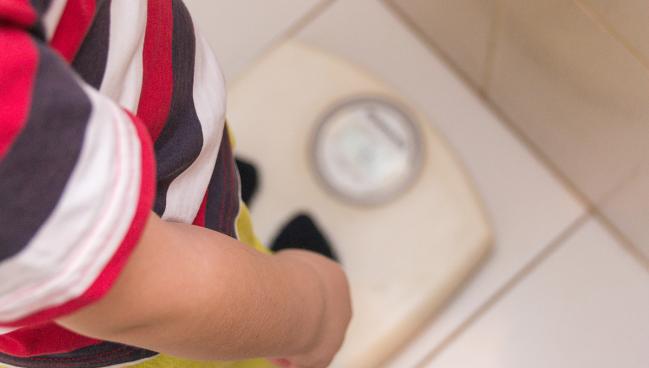Liraglutide Helps Shed Weight in Young Children With Obesity
These RCT findings support safety and efficacy in 6 to 12 year olds, but there are many unanswered questions, one expert says.

Liraglutide (Saxenda; Novo Nordisk) significantly reduces body weight in children ages 6 to 11 with obesity when combined with changes in lifestyle, results of the SCALE Kids trial show.
The mean percentage change in body mass index (BMI) from baseline to 56 weeks was -5.8% with liraglutide and +1.6% with placebo, for a between-group difference of -7.4% favoring treatment with the glucagon-like peptide-1 (GLP-1) receptor agonist (P < 0.001).
Claudia Fox, MD (University of Minnesota Medical School, Minneapolis), recently reported the results at the European Association for the Study of Diabetes annual meeting.
“Many children with obesity, particularly those with severe forms of obesity, are unable to have clinically meaningful outcomes with the current standard of care, which is lifestyle therapy,” Fox said. “These children are at risk for progressive weight gain and development of serious comorbidities, many of which are lifelong and will ultimately lead to premature death in many situations. So basically, bottom line is we just need more effective treatments.”
Although there is no consensus about what BMI reduction is clinically meaningful, “most believe that about a 5% BMI reduction”—enough to improve some cardiometabolic risk factors—would meet that definition, Fox told TCTMD.
Several secondary endpoints related to body weight and indicators of cardiometabolic health—including blood pressure and glycated hemoglobin—also favored liraglutide, according to findings that were published simultaneously online in the New England Journal of Medicine.
Liraglutide—as well as semaglutide (Wegovy; Novo Nordisk), another GLP-1 receptor agonist—is approved for chronic weight management in adults and adolescents as young as 12 years old, but neither has been cleared for younger children. No medications, in fact, have been approved for the treatment of obesity before age 12.
“The main point is to really underscore that this is a much-needed first-ever option for kids who are really struggling with obesity who aren't able to achieve any clinically meaningful effect with lifestyle therapy alone,” Fox said. “It will be life-changing for many kids.”
This is a much-needed first-ever option for kids who are really struggling with obesity who aren't able to achieve any clinically meaningful effect with lifestyle therapy alone. Claudia Fox
Katherine Morrison, MD (Centre for Metabolism, Obesity, and Diabetes Research, McMaster University, Hamilton, Canada), however, was circumspect in her interpretation of the results. The trial shows that liraglutide is safe and effective in this population, at least in terms of weight-related outcomes, but there are a lot of unanswered questions that still need to be addressed, she said.
“How we're actually going to fit this into a model of care, and which are the patients that would benefit the most and when, is something that we really don't know,” Morrison told TCTMD.
For starters, she pointed to the lack of information on quality of life. “Does it make a difference to their engagement, their self-esteem, the impact of weight-related teasing, all of those things that we know are incredibly relevant to this population of children and adolescents?”
She also highlighted the “pretty high” rate of discontinuation among the liraglutide-treated children, the low proportion of participants with cardiometabolic abnormalities, and the lack of insights into how body composition—not just weight—evolved with treatment.
“One of my really big concerns about this area of research is that we know that there's a reduction in appetite. All of the trials have been done with lifestyle therapies, so I'm assuming that a dietician has been assisting the families and ensuring that when they're consuming less food that it is adequate for their nutrient requirements and for their muscle development,” Morrison said. “But there's nothing about that in any of these studies, so I don't know what's happening to body composition. I don't know whether that's lean mass that they've lost or is it fat mass, or is it a combination of both, which is the most likely given what we've seen in adult studies that have actually looked at this.”
The SCALE Kids Trial
SCALE Kids was a phase IIIa trial conducted at 23 sites across nine countries. It consisted of a 2-week screening period, a 12-week run-in period, a 56-week treatment phase, and a 26-week follow-up. Investigators enrolled children ages 6 to < 12 years who had obesity, defined as an age- and sex-adjusted BMI in the 95th percentile or higher and pubertal development of Tanner stage 1 through 5 without type 1 diabetes or secondary causes of obesity.
Ultimately, 82 children (mean age 10 years; 46% female) were randomized 2:1 to once-daily subcutaneous liraglutide at the maximum tolerated dose (up to 3.0 mg) or placebo, both on top of lifestyle interventions that encouraged healthy eating and exercising. Mean BMI at baseline was 31 kg/m2, and most children had obesity defined as class 2 (37%) or class 3 (39%). More than half (55%) had at least one obesity-related complication.
The primary endpoint was the percentage change in BMI from baseline, which favored treatment with liraglutide. The drug also resulted in a lower percentage change in body weight (1.6% vs 10.0%; P = 0.001) and a greater likelihood of having a BMI reduction of 5% or more (46% vs 9%; adjusted OR 6.3; 95% CI 1.4-28.8).
During the 26-week follow-up period after treatment was stopped, BMI and body weight increased in both groups, albeit to a lesser extent in the liraglutide arm.
Nearly all other secondary endpoints favored liraglutide, except for waist circumference, which was not significantly different between the trial arms.
In terms of cardiometabolic risk factors, the participants entered the study with “essentially normal” levels of blood pressure and glycated hemoglobin, Fox said, but there tended to be favorable changes in both measures with liraglutide versus placebo.
Overall adverse events occurred at similar rates in the two trial arms. GI adverse events, however, were more frequent with liraglutide (80% vs 54%), with the difference mostly related to an increase in mild-to-moderate nausea and vomiting during the dose-escalation phase.
One in every nine children (11%) on liraglutide discontinued treatment due to adverse events, with no such stoppages in the placebo group.
Some Caution
As for whether the weight loss observed in the trial was meaningful, Morrison indicated that it’s too early to tell. “I think the way to know if it's meaningful is whether or not it has an impact on the health of the individual and I don't mean their size, I mean their health, and so I think that is how I would judge meaningfulness,” she said.
There were indications of improvements in cardiometabolic health over the course of the study, she said. “So one could project that if—and there's a few ifs here—these are children who have abnormalities, and if you're able to correct those, one would project that that should reduce their long-term health challenges,” Morrison said. “And I think that's important, but we have to look at those ifs, and none of the studies so far have targeted kids that have cardiometabolic difficulties.”
Morrison said this trial suggests liraglutide might be a benefit to, for example, a 10-year-old patient with type 2 diabetes or marked hypertension.
“I'm not sure that every 6- to 12-year-old who has an increased BMI, which is all they've measured in the study, should be put onto medication essentially for a lifetime,” she stressed. “Because what you're seeing here is that as soon as they come off, the weight goes up, which is exactly what we would expect from the physiology or pathophysiology of obesity, where we have a central as well as biological underpinnings that are contributing to energy imbalance.”
Another concern, Morrison said, is that children will be given a GLP-1 receptor agonist without the needed dietary support and recommendations around physical activity, something she’s observed already. “People are just putting them on the medication and that's it,” she said.
As soon as they come off, the weight goes up, which is exactly what we would expect from the physiology or pathophysiology of obesity. Katherine Morrison
Appropriate use of the medication is “obviously of concern as you move into the younger age group because you've got all of puberty and growth and things to be monitoring and if they're not getting adequate nutrition, I worry about those,” Morrison said. “I think we need a lot more information, and we need to get the message out that we don't just put people on medication and tell them to go away and they're going to get all better.”
Asked how extensively medications like liraglutide should be used to treat obesity in this younger age group, Fox said, “The message should not be that every child who has obesity should be started on an obesity medication. I think that would be missing the point.”
Instead, the message is that for children who have severe obesity and significant comorbidities who are not improving with lifestyle interventions, “it seems like we actually have an effective option” in liraglutide, she said. “It's not a blanket recommendation for every single kid out there who has maybe a slightly high BMI—that’s not what we're talking about.”
Todd Neale is the Associate News Editor for TCTMD and a Senior Medical Journalist. He got his start in journalism at …
Read Full BioSources
Fox CK, Barrientos-Pérez M, Bomberg EM, et al. Liraglutide for children 6 to < 12 years of age with obesity – randomized trial. N Engl J Med. 2024;Epub ahead of print.
Disclosures
- The trial was funded by Novo Nordisk.
- Fox reports grants/contracts to her institution from Eli Lilly and Novo Nordisk.





Comments